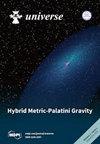宇宙学细丝中的高能粒子和高能过程及其天文学意义
IF 2.5
4区 物理与天体物理
Q2 ASTRONOMY & ASTROPHYSICS
引用次数: 0
摘要
大尺度宇宙细丝连接着星系、星团和空洞。它们被各种拓扑结构的磁场渗透。在与恒星形成和 AGN 活动相关的天体物理环境中会产生能量高达 1020eV 的宇宙射线。这些宇宙射线在地球上无法直接观测到的细丝中的命运很少被研究。我们采用一种生态学方法,将星系、星团/超星团和空洞作为星丝生态系统中的关键宇宙学结构,研究与星丝中的高能粒子(宇宙射线)相关的高能过程。我们推导了模拟丝状结构与这些结构之间界面的现象学,并研究了高能宇宙射线质子的转移和命运如何受到界面磁性的影响。我们考虑了丝状结构中的不同磁场配置,并评估了它们对宇宙射线的束缚以及在强子先驱产生和光对相互作用中的生存的影响。我们的分析表明,粒子的命运取决于它们在丝状生态系统中的起源位置,丝状结构就像 "高速公路",在星系、星系团和超星系团之间输送宇宙射线。丝状体还可以充当宇宙 "苍蝇纸",从宇宙空洞中捕捉能量高达 1018eV 的宇宙射线质子。我们的分析预测,在宇宙时间中不断积累的丝状体和空洞中存在着1012-1016eV宇宙射线质子群。这些质子不会因为光对或先驱产生而遭受巨大的能量损失,也不能被有效冷却。相反,它们形成了宇宙射线化石,记录了宇宙的发电史。本文章由计算机程序翻译,如有差异,请以英文原文为准。
Energetic Particles and High-Energy Processes in Cosmological Filaments and Their Astronomical Implications
Large-scale cosmic filaments connect galaxies, clusters, and voids. They are permeated by magnetic fields with a variety of topologies. Cosmic rays with energies up to 1020eV can be produced in astrophysical environments associated with star-formation and AGN activities. The fate of these cosmic rays in filaments, which cannot be directly observed on Earth, are rarely studied. We investigate the high-energy processes associated with energetic particles (cosmic rays) in filaments, adopting an ecological approach that includes galaxies, clusters/superclusters, and voids as key cosmological structures in the filament ecosystem. We derive the phenomenology for modelling interfaces between filaments and these structures, and investigate how the transfer and fate of energetic cosmic ray protons are affected by the magnetism of the interfaces. We consider different magnetic field configurations in filaments and assess the implications for cosmic ray confinement and survival against hadronic pion-producing and photo-pair interactions. Our analysis shows that the fate of the particles depends on the location of their origin within a filament ecosystem, and that filaments act as ‘highways’, channelling cosmic rays between galaxies, galaxy clusters, and superclusters. Filaments can also operate as cosmic ‘fly paper’, capturing cosmic ray protons with energies up to 1018eV from cosmic voids. Our analysis predicts the presence of a population of ∼1012–1016eV cosmic ray protons in filaments and voids accumulated continually over cosmic time. These protons do not suffer significant energy losses through photo-pair or pion production, nor can they be cooled efficiently. Instead, they form a cosmic ray fossil record of the power generation history of the Universe.
求助全文
通过发布文献求助,成功后即可免费获取论文全文。
去求助
来源期刊

Universe
Physics and Astronomy-General Physics and Astronomy
CiteScore
4.30
自引率
17.20%
发文量
562
审稿时长
24.38 days
期刊介绍:
Universe (ISSN 2218-1997) is an international peer-reviewed open access journal focused on fundamental principles in physics. It publishes reviews, research papers, communications, conference reports and short notes. Our aim is to encourage scientists to publish their research results in as much detail as possible. There is no restriction on the length of the papers.
 求助内容:
求助内容: 应助结果提醒方式:
应助结果提醒方式:


